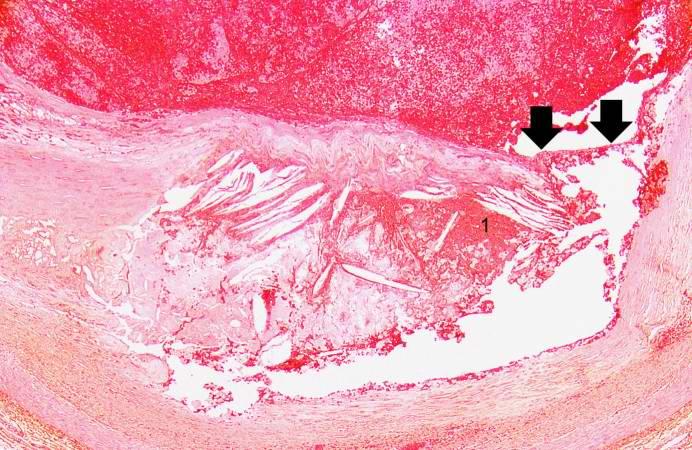Unstable angina non ST elevation myocardial infarction epidemiology and demographics
| Unstable angina pectoris | |
 | |
|---|---|
| Plaque rupture in a coronary artery at arrows yielding obstructive thrombus in red. Image courtesy of Professor Peter Anderson DVM PhD and published with permission © PEIR, University of Alabama at Birmingham, Department of Pathology | |
| ICD-10 | I20 |
| ICD-9 | 413 |
| DiseasesDB | 8695 |
| eMedicine | med/133 |
| MeSH | D000787 |
| Cardiology Network |
 Discuss Unstable angina non ST elevation myocardial infarction epidemiology and demographics further in the WikiDoc Cardiology Network |
| Adult Congenital |
|---|
| Biomarkers |
| Cardiac Rehabilitation |
| Congestive Heart Failure |
| CT Angiography |
| Echocardiography |
| Electrophysiology |
| Cardiology General |
| Genetics |
| Health Economics |
| Hypertension |
| Interventional Cardiology |
| MRI |
| Nuclear Cardiology |
| Peripheral Arterial Disease |
| Prevention |
| Public Policy |
| Pulmonary Embolism |
| Stable Angina |
| Valvular Heart Disease |
| Vascular Medicine |
Template:WikiDoc Cardiology News Editor-In-Chief: C. Michael Gibson, M.S., M.D. [1]
Associate Editor-In-Chief: Cafer Zorkun, M.D., Ph.D. [2]
Please Join in Editing This Page and Apply to be an Editor-In-Chief for this topic: There can be one or more than one Editor-In-Chief. You may also apply to be an Associate Editor-In-Chief of one of the subtopics below. Please mail us [3] to indicate your interest in serving either as an Editor-In-Chief of the entire topic or as an Associate Editor-In-Chief for a subtopic. Please be sure to attach your CV and or biographical sketch.
Synonyms and related keywords: progressive angina, crescendo angina, accelerating angina, new-onset angina, pre-infarction angina, unstable angina pectoris, UAP, UA
Definition of Unstable Angina Pectoris
Unstable angina pectoris is chest pain which is ischemic in origin and either occurrs more frequently, lasts longer, and/or manifests with lesser degrees of exertion than stable angina. It can occur at rest and/or at night. Unlike ST elevation MI (STEMI) or non ST elevation MI (NSTEMI), there no sign of myocardial necrosis and there is no release of biomarkers of myonecrosis (CK or troponin) in unstable angina pectoris. [1] [2]
Angina pectoris is classified as stable when its characteristics are unchanged for 60 days. Stable angina pectoris usually responds to sublingual nitroglycerin or rest.
Epidemiology and Demographics of Unstable Angina Pectoris
Over 9 million patients in the United States alone have angina. An estimated 80,700,000 American adults (one in three) have one or more types of cardiovascular disease (CVD), of whom 38,200,000 are estimated to be age 60 or older. Except as noted, the estimates were extrapolated to the U.S. population in 2005 from NHANES 1999–2004. (Total CVD includes diseases in the bullet points below except for congenital heart disease). Due to overlap, it is not possible to add these conditions to arrive at a total. [3] [1] [2]
- Hypertension: 73,000,000
- Coronary heart disease: 16,000,000
- Myocardial infarction: 8,100,000
- Angina pectoris: 9,100,000
- Heart failure: 5,300,000
- Stroke: 5,800,000
- Congenital heart disease: 650,000 – 1,300,000
The following prevalence estimates are for people age 18 and older from NCHS/NHIS, 2005: [4]
- Among whites only, 12.0% have heart disease, 6.6% have CHD, 21.0% have hypertension and 2.3% have had a stroke.
- Among blacks, 10.2% have heart disease, 6.2% have CHD, 31.2% have hypertension and 3.4% have had a stroke.
- Among Hispanics or Latinos, 8.3% have heart disease, 5.9% have CHD, 20.3% have hypertension and 2.2% have had a stroke.
- Among Asians, 6.7% have heart disease, 3.8% have CHD, 19.4% have hypertension and 2.0% have had a stroke.
- Among Native Hawaiians or other Pacific Islanders, 22.4% have hypertension (other prevalence estimates considered unreliable).
References
- ↑ 1.0 1.1 Anderson JL, Adams CD, Antman EM, Bridges CR, Califf RM, Casey DE Jr, Chavey WE II, Fesmire FM, Hochman JS, Levin TN, Lincoff AM, Peterson ED, Theroux P, Wenger NK, Wright RS. ACC/AHA 2007 guidelines for the management of patients with unstable angina/non–ST-elevation myocardial infarction: a report of the American College of Cardiology/American Heart Association Task Force on Practice Guidelines (Writing Committee to Revise the 2002 Guidelines for the Management of Patients With Unstable Angina/Non–ST-Elevation Myocardial Infarction). Circulation 2007 116: e148 – e304. PMID 17679616
- ↑ 2.0 2.1 Anderson JL, Adams CD, Antman EM, Bridges CR, Califf RM, Casey DE Jr, Chavey WE II, Fesmire FM, Hochman JS, Levin TN, Lincoff AM, Peterson ED, Theroux P, Wenger NK, Wright RS. Correction of ACC/AHA 2007 guidelines for the management of patients with unstable angina/non–ST-elevation myocardial infarction: a report of the American College of Cardiology/American Heart Association Task Force on Practice Guidelines (Writing Committee to Revise the 2002 Guidelines for the Management of Patients With Unstable Angina/Non–ST-Elevation Myocardial Infarction). J Am Coll Cardiol. 2008 Mar 4; 51(9): 974. PMID 17692738
- ↑ 2008 Heart Disease and Stroke Statistics
- ↑ Vital Health Stat 10.2006 [232]: 1–153